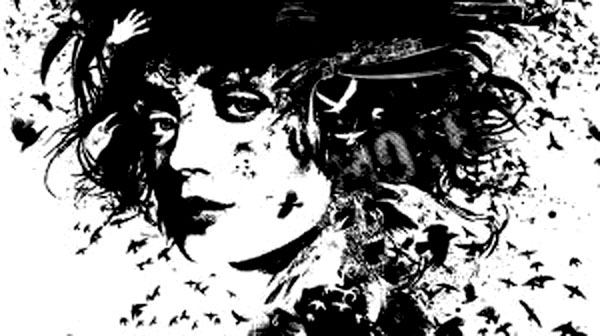BLACKBIRDS: Miriam Black, Mental Evaluation
Blackbirds is a midnight page-turner of a road novel written by the nefarious Chuck Wendig. It will breathe his love of horror, concise, tense prose and savant vulgarity into your brain. Read it. (and click Blackbirds here or above to buy it—but if you read on now, you will find spoilers.)
Miriam Black is the broken spindle on which this story spins. She can see how you die with just a touch. She can’t change it with every ounce of her being. Welcome to conflict, the hated lover of every reader. But just how broken is this spindle?
As I said when I wrote Jared Lee Loughner’s Mental Evaluation, I aid in the writing of psychiatric evaluations for psychiatrists but I am not a psychiatrist, thus this is not a psychiatric evaluation. Plus, Miriam’s not real. This evaluation is from the point-of-view that Miriam’s death visions exist as part of the narrative, and are factual and not treatable. I guess, since this is an evaluation that accepts and interacts with Miriam as a real person, it is also a work of fan fiction. It was unexpected, but there you are.
Finally, as the picture and parenthetical interjection warned, there be spoilers ahead.
 Name: Miriam Black
Name: Miriam Black
Date of Birth: Unknown (Patient indicated that “It’s none of your monkey-f***ing business,” but with pleasant affect and apparent cheerful mood)
Relevant Information
Patient was evaluated seeking outpatient therapy, due to reported difficulty maintaining healthy long term relationships, residences and holding employment. Patient complained of nightmares, hallucinations, feelings of amorphous paranoia and general threat, “Fate gets what fate wants,” repeated unsuccessful heterosexual relationships which resulted in physical or emotional abuse, difficulty reaching orgasm, unsuccessful heterosexual relationships with men she viewed as “good guys” due to reported lack of interest, and a consistent feeling of disconnection from most people. It was observed that the patient’s mood was often labile (moving from polarities of joking to anger to dysthemia), that her affect would at be incongruent with her mood (joking though angry, smiling though saddened); that her hygiene was fair with evidence of multiple dyes to her hair and nails (currently black, residual reds). Patient complained repeatedly of needing “a cigarette for this s***.” Patient also noted that during her teens she began having premonitions of a person’s death upon physical contact with them.
Family & Social History
Patient reported being estranged from her mother following a miscarriage. Father died of bowel cancer when patient “was very young.” Patient reported that she was raised in a strict Bible-believing household, which she found repressive. She noted that the boy who she had lost her virginity to (and the father of the potential baby) had killed himself, which she said was her fault because of treating him poorly. She first said that she has no friends, then clarified that “there’s this one Frankenstein motherf******,” but she refused to speak further on the topic.
Hobbies and Interests
The patient remains mobile, so she has not been able to root herself into a community long enough to establish a routine of shared interests. However, she said that journaling has been beneficial to her in dealing with guilt and seems to enjoy amassing eclectic knowledge from the internet.
Diagnosis
AXIS I: 309.81 Post Traumatic Stress Disorder, Chronic; 309.4 Adjustment Disorder
with Mixed Disturbance of Emotions and Conduct, Chronic Stressor; 292.9 Nicotine Dependence
AXIS II: Narcissistic Personality Traits
AXIS III: Miscarriage, by History
AXIS IV: Problems with primary support group (estranged from family, no friends), Problems related to the social environment (no long-term environment; drifter), Occupational problems (no employment), Housing problems (no set address), Other problems (visions).
AXIS V: Global Assessment of Function: 42
Discussion
The Nicotine Dependence is standard and based on present desire and the patient’s description of her level of addiction to smoking cigarettes. (DSM-IV-TR, 2000; BehaveNet, Nicotine Dependence, 2012)
The main trigger of the Post Traumatic Stress Disorder appears to be the witnessed death of a young boy via vehicular homicide. The UCLA Trauma Inventory was administered with positive assessment of PTSD in the following DSM-IV-TR criteria. It is noteworthy that the trauma appears compounded by feelings of responsibility for the death as Miriam believes that she caused the death in her attempt to stop it. An early contributing trauma was also the loss of a baby via miscarriage and it appears that the patients conflicted inward rejection (though initial outward acceptance) of her mother’s strict code of repression may have fostered a negative self image fulfillment cycle and misplaced sense of responsibility that increased her risk of traumatization.
DSM-IV-TR Criteria (DSM-IV-TR, 2000; BehaveNet, PTSD, 2012)
A. “(1) the person experienced, witnessed, or was confronted with an event or events that involved actual or threatened death or serious injury, or a threat to the physical integrity of self or others (2) the person’s response involved intense fear, helplessness, or horror…” Noted in the death of the boy.
B. “The traumatic event is persistently re-experienced in one (or more) of the following ways: (1) recurrent and intrusive distressing recollections of the event, including images, thoughts, or perceptions. (2) recurrent distressing dreams of the event. (3) acting or feeling as if the traumatic event were recurring (includes a sense of reliving the experience, illusions, hallucinations, and dissociative flashback episodes, including those that occur on awakening or when intoxicated).” Noted in the patient’s report of having dreams, nightmares and waking hallucination.
C. “Persistent avoidance of stimuli associated with the trauma and numbing of general responsiveness…, as indicated by three (or more) of the following: (1) efforts to avoid thoughts, feelings, or conversations associated with the trauma…(5) feeling of detachment or estrangement from others (6) restricted range of affect (e.g., unable to have loving feelings) (7) sense of a foreshortened future (e.g., does not expect to have a career, marriage, children, or a normal life span)” Noted in the patient’s statements endorsing repression, avoidance, incidents when her affect is incongruent with her mood, her reports of feeling like an outcast, her difficulties in relationships and reported difficulty reaching orgasm.
D. “Persistent symptoms of increased arousal (not present before the trauma), as indicated by two (or more) of the following: (1) difficulty falling or staying asleep (2) irritability or outbursts of anger…(4) hypervigilance.” Noted in patient’s report of sleep difficulties, her observed labile and angry manner, the high incidents of personal anecdotes which involve the retelling of angry rants and her statements of carrying an array of self defense weaponry in her purse.
An Adjustment Disorder (with Mixed Disturbance of Mood and Conduct), as noted in the DSM-IV-TR is characterized by “significant life events, whether positive or negative” which “stress us emotionally and psychologically” and cause “the development of emotional or behavioral symptoms…[which] are clinically significant as evidenced by either of the following: (1) marked distress that is in excess of what would be expected from exposure to the stressor (2) significant impairment in social or occupational (academic) functioning. (DSM-IV-TR, 2000; BehaveNet, Adjustment Disorder, 2012)
The patient reports that much of her socially incongruent behavior, fatalistic outlook on life and relational conflict is the result of the “seeing how someone dies if I touch them.” Discussion of if this is actual psychometric precognitive phenomena or a possible brief dissociated state or psychosis related to PTSD which is triggered by physical contact is presently irrelevant, as the patient believes that these are “visions.” Her inability to successfully adjust, to the life-change that these “visions” bring, and incorporate them into healthy living appears chronic in nature.
Narcissistic Personality Traits may be present in the patient’s pathologically grandiose sense of responsibility for the deaths of those around her. The patient detailed a sense of ownership of the deaths, either in the role of a sole witness, the form of a steward who participates in the unfolding of the actual events (though not murderously), or even the person who begins the chain of events which will bring about a person’s death. This pattern was observed when she reported that she “bumped into” this Examiner while at the local convenience store earlier today. She admonished me to not “stop for tacos” on Friday, then began muttering to herself that “Great, I probably just made him want tacos” and would therefore cause my demise. The patient does not appear to exhibit enough narcissistic qualities to represent an actual personality disorder, and it is likely that the narcissism is symptomic of the unresolved adjustment disorder surrounding her perceived abilities. (DSM-IV-TR, 2000; BehaveNet, NPD, 2012)
Recommendations
It is therefore recommended that the patient would benefit from outpatient therapy on an initial bi-weekly basis with the option of titration to weekly sessions once reduction of symptoms is evident. Trauma Focused Cognitive Behavioral Therapy could be beneficial or possible Dialectic Behavioral Therapy could be employed due to the early childhood repression and present patient reactivity. This Examiner should not be the practitioner, in that she seems to have already fixated on me as a foci of her presenting problems, though I would be willing to assist in sessions as an object lesson to dispute the fatality of her “visions” in the event that I am still living at the commencement of therapy.
___________________________________________________________________________________________
American Psychiatric Association. (2000). Diagnostic and statistical manual of mental disorders (4th ed., text rev.). Washington, DC: Author
BehaveNet.com provided the discussion sections on Nicotine Dependence, PTSD, Adjustment Disorder and Narcissistic Personality Traits, which it reprinted verbatim from the DSM-IV-TR. (www.behavenet.com).
Michigan State University. (2012). Global Assessment of Functioning. Retrieved from https://www.msu.edu/course/sw/840/stocks/pack/axisv.pdf


